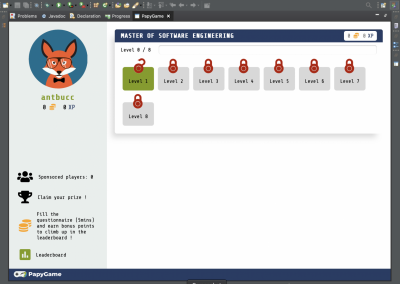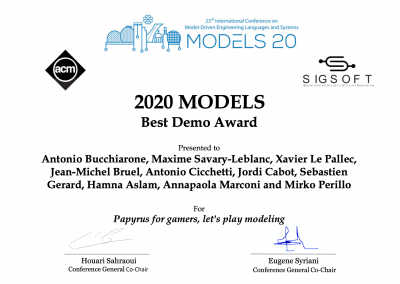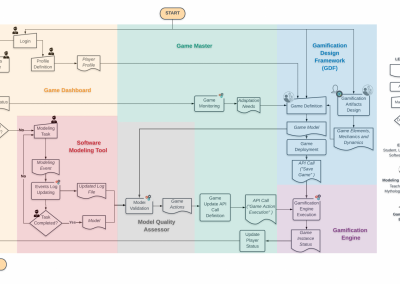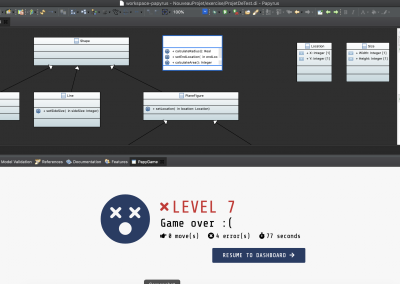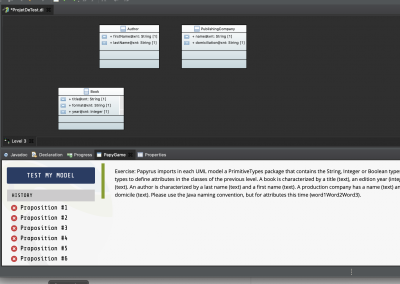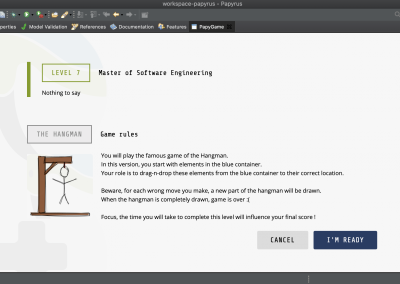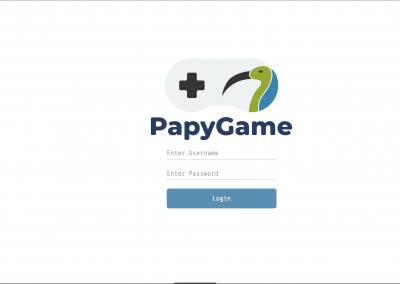In PapyGame the Papyrus modeling tool has been extended with gamification features. The objective of the gamification is to help master degree students in Computer Science to learn specific modeling aspects using Papyrus for UML. Each student assignment in PapyGame is composed of a set of Levels (grouped in Series) that each student should deal with. For each level, an exercise is assigned, and each passed level unlocks the next exercise of the next level. To start a PapyGame session, the player must first enter their login and password. Once connected, PapyGame displays a Dashboard representing the player’s series. Each successfully completed level is displayed in green with the corresponding number of gold coins (GC) and experience points (XP) rewarded. Remaining levels are colored in gray with a lock, except for the first one which is the next level to be played (unlocked).
Each exercise is associated with a specific game type: the Hangman — when a new part of the man drawing is added with every wrong answer, and the On Your Own (OYO) — when the student executes the exercise with no help. At the same time, each exercise has an associated set of point concepts (experience points, gold coins, etc.) and rules. All these aspects are defined by the teacher by using GDF. In particular the teachers execute the following steps in defining each level: (1) choose a game type among the available games in the system (i.e, Hangman, OYO); (2) define the goal and the description of the level; (3) create the expected (correct) diagram in Papyrus according to the level objective; and (4) create the reward rules about points and eventual bonuses.
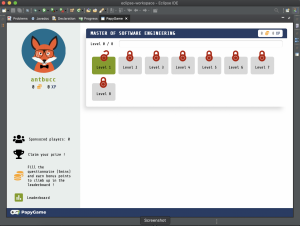
Once theare designed and deployed, the students can select the respective levels and start playing and accumulating points. See the following figure as an example. It presents the associated UML diagram containing a set of classes connected with the generalization relationship. The goal of this level is to help players/students associate the correct attributes and operations with the correct class in the hierarchy. This is done using a drag-and-drop facility. An incorrect user selection (moving an operation into a class that is not the one that should contain it) adds a part of the hangman’s body (lower part of the example). If the player manages to place all operations correctly without the body of the hanged person being completely displayed, they win. The number of gold coins and XP is calculated according to the number of errors (incorrect drag-and-drops). If the hangman’s body is completely displayed, the player loses and the next level stays unlocked. As a consequence, they will have to play the same level again. Whether the player wins or loses, after the completion of a PapyGame game they are returned to the Dashboard view.

Our approach caters to three principal stakeholders:
- Gamification Expert: who designs and develops appropriate gamification artifacts (i.e., game elements, mechanics and dynamics) in line with the learning goals;
- Modeling Teaching Expert (e.g., Teacher, Methotodologist, or Tool Vendor) that in collaboration with the gamification expert defines the game including the expected pedagogical principles, the global learning goals and the suitable progression of learning steps with their intermediate learning goals;
- End-Users (i.e., Student, Language Expert, or Software Developer), that use the gamified version of the software modeling tool to learn modeling with a given tool or even enhance their modeling expertise level while gaming.
RELEVANT PUBLICATIONS
- Antonio Bucchiarone, Antonio Cicchetti, Nelly Bencomo, Enrica Loria, Annapaola Marconi: Gamified and Self-Adaptive Applications for the Common Good: Research Challenges Ahead. SEAMS@ICSE 2021: 149-155
- Antonio Bucchiarone, Nelly Bencomo, Enrica Loria, Annapaola Marconi, Antonio Cicchetti: Run-time and Collective Adaptation of Gameful Systems. ACSOS Companion 2020: 145-146
- Antonio Bucchiarone, Maxime Savary-Leblanc, Xavier Le Pallec, Jean-Michel Bruel, Antonio Cicchetti, Jordi Cabot, Sebastien Gerard, Hamna Aslam, Annapaola Marconi, Mirko Perillo: Papyrus for gamers, let’s play modeling. MODELS Companion 2020: 5:1-5:5
- Antonio Bucchiarone, Antonio Cicchetti, Annapaola Marconi: Towards engineering future gameful applications. ICSE (NIER) 2020: 105-108
- Antonio Bucchiarone, Antonio Cicchetti, Annapaola Marconi: Exploiting Multi-level Modelling for Designing and Deploying Gameful Systems. MoDELS 2019: 34-44
- Antonio Bucchiarone, Antonio Cicchetti, Annapaola Marconi: GDF: A Gamification Design Framework Powered by Model-Driven Engineering. MODELS Companion 2019: 753-758

